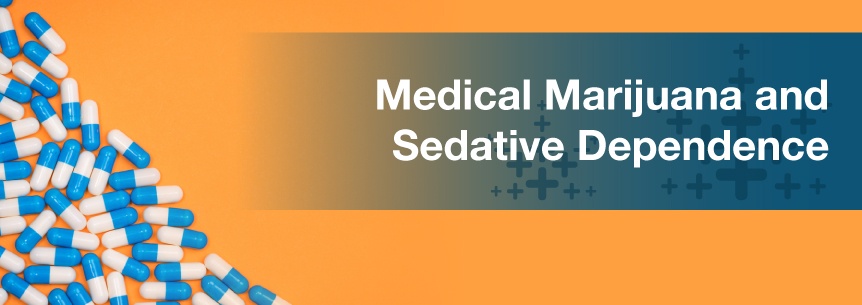
Sedative dependence and addiction are very real, and more and more individuals are falling victim to them. Like with withdrawing from opioids, doctors and detox centers turn to other drugs like suboxone to help with sedative withdrawal. The issue with this, however, is these drugs can also become addictive, leading users to a different problem.
Fortunately, there are other options available to treat substance misuse and addictions like this which don’t pose too much of a risk for dependence, including medical cannabis for sedative dependence.
Sedatives are prescription medications that help promote calmness and sleep. They go under the classification of central nervous system (CNS) depressants. Tranquilizers, alcohol, and opioids like benzodiazepines and OxyContin fall under the CNS depressant classification.
Sedative drugs help treat sleep and anxiety problems. However, over long-term use, they can lead to dependence and addiction. They slow brain activity.
There are three primary classes of sedative drugs.
1. Benzodiazepines: Patients use these medications for treating muscle spasms, seizures, and anxiety before a medical procedure. Some examples of benzos are Valium, Xanax, and Librium.
2. Barbiturates: You may take these medications by themselves or along with anesthesia. Physicians sometimes prescribe these for treating seizure disorders. Some examples of barbiturates are phenobarbital and pentobarbital.
3. “Z-drug” sleep medicines: These medications act on a certain central nervous system receptor known as BZ1, making their sleep aid action very targeted. Some examples of “Z-drug” medicines are Lunesta, Ambien, and Sonata.
Your central nervous system consists of your spinal cord and brain. When you use CNS depressant agents, your heart and breathing slow down. If they slow down too much, you lose consciousness and could go into a coma, or worse, die. Despite their high risk of these things, they’re still on the list of commonly abused prescription or illicit drugs.
When you use a CNS depressant, you don’t feel anxious, and you can sleep better. The most currently used sedatives are sleep medications and barbiturates.
Using sedatives regularly can cause your body to build a tolerance, meaning your body requires more of the drug to experience the same effects. This tolerance can lead to dependence, resulting in withdrawal symptoms when you don’t take the medication. Tolerance and dependence can gradually turn into a sedative addiction.
An individual who abuses sedatives will also show noticeable signs of sedative dependence, including:
The symptoms are different for each user and depend on which sedative they’re abusing. For instance, if you abuse Amytal, you might become suddenly irritable, stagger or reveal specific information you would otherwise keep secret. If you abuse the Ambien sleep aid, you may become drowsy, but still get behind the wheel of your vehicle. You may also go about your day without remembering anything that occurred.
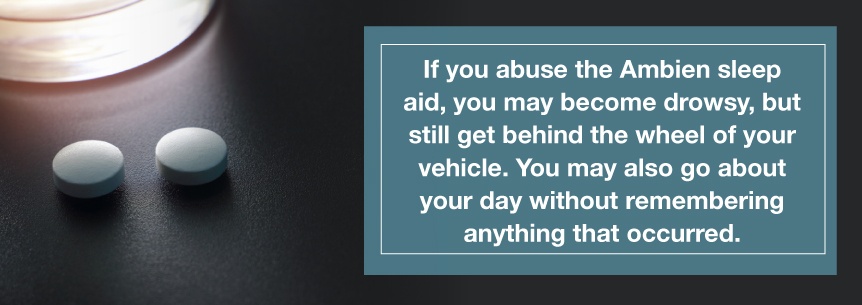
While signs of dependence can be subtle, if you’re concerned you are becoming dependent or addicted to sedatives, there are certain warning signs. The first sign of addiction is having to increase your regular dose of the drug to achieve the same effect, due to your body building up a tolerance to the drug.
Cravings are also a primary sign of sedative dependence. If you miss a dose, or stop using a certain sedative and begin feeling an intense desire for the drug again, you could be experiencing cravings for the drug that indicate dependence.
If you experience withdrawal symptoms when you miss a dose or stop using the sedative, this could indicate a chemical dependence. Sedative withdrawal symptoms may include:
If you’re worried about a loved one who could be abusing a sleep aid or sedative, you can be on the lookout for specific behavioral signs that point to a dependence, including:
Those who have sedative dependence start the process by increasing their prescribed dose without medical advice. They usually do this because their bodies become tolerant to the sedative. Individuals who intentionally take sedatives at larger doses will typically purchase the drugs for recreational use off the streets, or they might obtain them from friends or family members who have legal prescriptions.
When people take sedatives at higher doses, they’re at risk of more severe symptoms, including:
With prolonged use of these drugs, some individuals experience:
They might have trouble thinking and understanding other people and may speak slowly, or have nystagmus, which is a condition that causes people to have involuntary eye movements.
The type and dose of the abused drug determine the extent of a person’s withdrawal symptoms. Symptoms could start within 12 to 24 hours of stopping use.
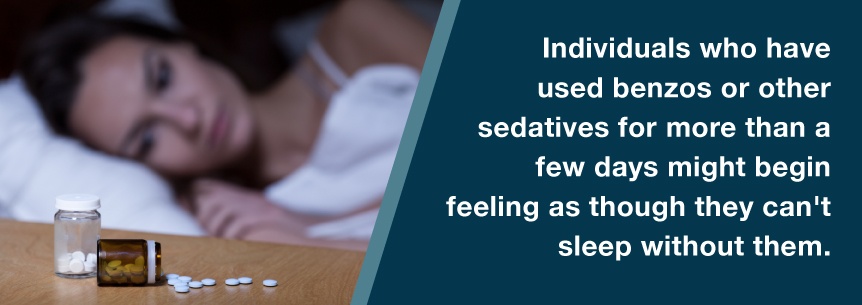
Individuals who have used benzos or other sedatives for more than a few days might begin feeling as though they can’t sleep without them. When they stop taking the drug, they might start experiencing mild withdrawal symptoms like:
More severe symptoms of withdrawing from benzos might include rapid breathing, rapid heart rate, confusion and in some cases, seizures.
You can experience severe barbiturate withdrawal reactions if you take them at high doses and stop abruptly. The abrupt withdrawal can produce severe and even life-threatening reactions, similar to alcohol withdrawal. Other withdrawal symptoms may include:
Because severe reactions can occur during the withdrawal process, individuals typically need to remain hospitalized during this time.
A sedative dependence doesn’t necessarily mean you’re addicted. It can be hard to tell the difference. However, certain symptoms indicate you’ve formed an addiction. These symptoms may include:
Sedatives can also make the abuser anxious and depressed or alternating between the two.
The National Institute of Drug Abuse provides the following statistics about sedative dependence:
Physicians typically make a sedative dependence diagnosis based on the type of drugs individuals take or by what their friends say they ingest. Doctors might conduct tests to rule out other potential reasons for the patient’s symptoms if it’s not clear why they’re acting confused or sleepy. A couple of examples are tests for head injury or low blood sugar levels.
While certain types of drug screenings can detect barbiturates and benzodiazepines, finding them in a person’s system doesn’t necessarily mean these medications are the cause of their symptoms. Most hospital labs can’t measure most sedative blood levels.
If you’ve taken a sedative overdose, you require immediate medical attention. A barbiturate overdose is just as dangerous as a benzos overdose. If you’ve taken a dangerous overdose of sedatives or anti-anxiety drugs, you could suffer significant heart, blood pressure, and respiratory problems. You should have a hospital stay where medical professionals can monitor you closely, such as in the intensive care unit.
Supportive care might include:
There is an antidote for benzos called flumazenil, and it can reverse a severe overdose. However, it can also trigger a benzos withdrawal and lead to seizures in individuals who have taken benzos for a long period. Therefore, doctors don’t routinely provide flumazenil for overdose.
For a barbiturate overdose, doctors can provide intravenous sodium bicarbonate to help the individual excrete the drug in their urine.
Those experiencing mild withdrawal symptoms need psychological and social support to help them overcome their strong urges of beginning to use the drug again to stop their anxiety.
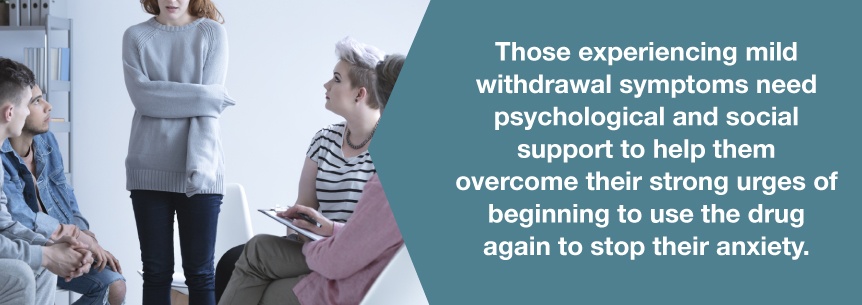
Those with severe withdrawal symptoms typically require hospital treatment — in some cases, in an ICU so doctors and nurses can monitor them closely. In this setting, the doctors will provide them with low intravenous doses of the drug and gradually decrease the dose over days or weeks before cutting it off completely. They may also substitute a similar drug that’s easier to withdraw from slowly. Even if they receive the best treatment, individuals might not feel normal for a month or so.
Doctors’ recommended strategy of facilitating the withdrawal of benzos is to reduce the drug incrementally, either by stepping down the dose or by replacing the drug with another medication that has a longer half-life. Sadly, the success rate of this strategy is low, since 80 percent of individuals who try and quit end up relapsing due to not being able to tolerate the withdrawal symptoms. Because of this, researchers are trying to find new strategies to overcome the difficulties associated with withdrawal.
One particular study is to test the effectiveness of a novel psychosocial intervention called PASSE-65+ for facilitating benzos withdrawal in older users, thereby providing physicians with a new therapeutic tool.
Instead of viewing marijuana as a gateway to dependence and addiction, which doesn’t have research to support it, patients involved in cannabis-friendly treatment use it as a path to recovery.
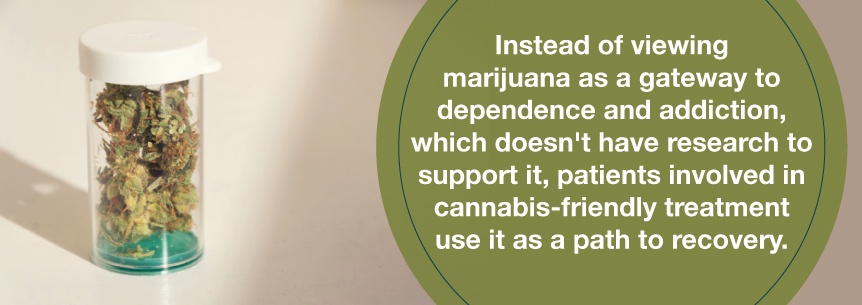
If you check yourself into a reputable detox center for alcohol, you’ll immediately take addictive benzos for treatment. If you’re in the facility to detox from OxyContin, heroin or your preferred opiate, the specialist will give you an opioid called suboxone, which is also highly addictive.
Using medical marijuana and sedative dependence treatment could be the first step to promoting recovery with a natural plant medication.
Medical weed is proven to be safe and doesn’t pose much risk to patients who consume it. Research has shown the herb to sustain anti-anxiety effects, and that it could work similarly to some prescription drugs. And, while benzos have a long list of adverse side effects, making them a less beneficial treatment option for your body, medical marijuana for sedative dependence has only a few mild side effects, including:
As more studies mount in this area, we are finally starting to understand more about how medical pot’s cannabinoids interact with the body. Perhaps the most significant discovery to date is the interaction between CBD and THC with the human endocannabinoid system.
Some evidence shows CBD, one of the main components in medical cannabis, helps stop opioid dependence cravings.
Other research shows people who turn to medical marijuana for pain relief can avoid more addictive and harmful drugs. Some people substitute pot for prescription medications like opioids.
For people using opioids to relieve their painful disorders, taking them off these highly addictive medications can have a positive impact on their health and well-being. They can use medical pot combined with opioids, which will lower their need for bigger doses. Also, they can wean off opioids or other sedatives and still treat their symptoms with medical weed at the same time.
Some symptoms cannabis for sedative dependence can help treat include:
Some good strains to try for sedative dependence are as follows.
There are a variety of methods for medical cannabis for sedative dependence treatment. These include:
Doctors caution against smoking cannabis because of the potential respiratory effects. The best method for you comes down to personal preference. Some individuals like edibles, whereas others prefer tinctures. You need to work with your marijuana doctor and budtender while experimenting with different methods.
To learn more about how you can treat your sedative dependence and the withdrawals of stopping use with medical marijuana treatment, book your appointment with one of our qualified cannabis doctors here at MarijuanaDoctors.com for your marijuana for sedative dependence treatment. They’re licensed and experienced to recommend cannabis. We also have an extensive dispensary directory to help you find your cannabis products. Experienced dispensary staff can help you choose products and suggest proper delivery methods for your cannabis treatment.
Book Appointment | Back to List
Find A Doctor Find A Dispensary